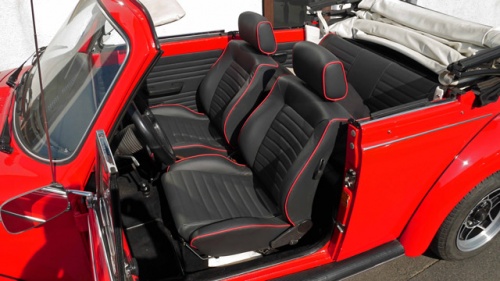Difference between revisions of "Leather piping"
| (One intermediate revision by one user not shown) | |||
| Line 4: | Line 4: | ||
| − | == | + | ==What is piping or leather piping?== |
| − | Piping | + | Piping refers to narrow, round, or flat cords or strings that are commonly incorporated into the seams of [[car leather|automotive]] or [[furniture leather|furniture]] upholstery. Piping helps enhance the appearance and durability of upholstery, whether it's in car seats, furniture, or other upholstery applications. Piping is often color-matched to the rest of the leather, although occasionally intentionally different in color. |
| + | |||
| + | Piping serves various purposes: | ||
| + | * Aesthetic function: Piping provides a clean and professional appearance to upholstery. It can serve as a decorative element and elevate the look of [[leather seams|seams]]. | ||
| + | * Protective function: Piping can reinforce seam areas and protect against abrasion, wear, and damage. It offers additional stability and durability. | ||
| + | * Covering function: Piping can cover edges or seams, concealing unsightly or rough areas. This contributes to a smooth surface of the upholstery material. | ||
| + | |||
| + | |||
| + | Piping can be used with a variety of upholstery materials, including: | ||
| + | * [[Genuine leather]]: iping is also used in upholstery made from genuine leather. It helps reinforce seams, create a clean edge, and protect the leather from abrasion and damage. | ||
| + | * [[Synthetic leather]]: Piping is also employed in upholstery made from synthetic leather, commonly known as vinyl. Vinyl is a synthetic material used in furniture, car seats, [[boat leather|boat]] cushions, and other applications. Piping is used here to reinforce seams and provide additional stability to the material. | ||
| + | * Fabrics: Piping is commonly used with upholstery fabrics such as cotton, polyester, velvet, chenille, and others. It is utilized in the manufacturing of upholstered furniture, headboards, pillows, and other textile-based upholstery. | ||
| + | |||
| + | |||
| + | The insertion of piping requires specialized sewing techniques. Typically, a piping cord or tape is used, which is enclosed within the seam. The piping cord or tape is placed along the edge of the fabric and then securely sewn using a specialized piping foot sewing machine or another suitable sewing machine. | ||
| Line 57: | Line 71: | ||
== Additional information == | == Additional information == | ||
* [[Car leather]] | * [[Car leather]] | ||
| + | * [[Sewing leather - decorative seams in leather|Sewing leather]] | ||
Latest revision as of 11:45, 19 June 2023
What is piping or leather piping?
Piping refers to narrow, round, or flat cords or strings that are commonly incorporated into the seams of automotive or furniture upholstery. Piping helps enhance the appearance and durability of upholstery, whether it's in car seats, furniture, or other upholstery applications. Piping is often color-matched to the rest of the leather, although occasionally intentionally different in color.
Piping serves various purposes:
- Aesthetic function: Piping provides a clean and professional appearance to upholstery. It can serve as a decorative element and elevate the look of seams.
- Protective function: Piping can reinforce seam areas and protect against abrasion, wear, and damage. It offers additional stability and durability.
- Covering function: Piping can cover edges or seams, concealing unsightly or rough areas. This contributes to a smooth surface of the upholstery material.
Piping can be used with a variety of upholstery materials, including:
- Genuine leather: iping is also used in upholstery made from genuine leather. It helps reinforce seams, create a clean edge, and protect the leather from abrasion and damage.
- Synthetic leather: Piping is also employed in upholstery made from synthetic leather, commonly known as vinyl. Vinyl is a synthetic material used in furniture, car seats, boat cushions, and other applications. Piping is used here to reinforce seams and provide additional stability to the material.
- Fabrics: Piping is commonly used with upholstery fabrics such as cotton, polyester, velvet, chenille, and others. It is utilized in the manufacturing of upholstered furniture, headboards, pillows, and other textile-based upholstery.
The insertion of piping requires specialized sewing techniques. Typically, a piping cord or tape is used, which is enclosed within the seam. The piping cord or tape is placed along the edge of the fabric and then securely sewn using a specialized piping foot sewing machine or another suitable sewing machine.
Colour contrasting leather piping in a car.
Leather piping on furniture.
Imitation leather piping in a car and in a plane.
In the leather workshop, leather can be dyed if the colour of the leather has been damaged by use. In the case of contrasting colours, it is necessary to work very carefully. The time required for a colour correction increases immensely when the piping or the seam is of a different colour. Then a narrow adhesive tape comes in very handy.
For leather repair companies, especially narrow adhesive tapes are available at Lederzentrum.
Additional information


















 a kotori web solution
a kotori web solution